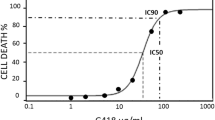Abstract
In addition to the characteristic development of the rod-shaped or tube-like endocytobionts replicating within the sol-like cytoplasm of acanthamoebae which was published recently (Michel et al. 2003) we observed the strange behavior of the endoparasites described as follows. The material normally forming the characteristic cell walls of KC5/2 organisms was found to form a long array along the borderline between the granuloplasm and the central homogenous sol-like cytoplasm, so that about one third of the sol plasm had already been surrounded. We do not know whether this process belongs to the normal developmental repertoire of the endocytobiont that was interrupted by fixation for electron microscopy, or whether it is an aberrant behavior.
Similar content being viewed by others
Avoid common mistakes on your manuscript.
The unique endocytobiont "KC5/2", which replicates in various Acanthamoeba strains, is characterized by an outstanding pleomorphy (Hoffmann et al. 1998; Michel et al. 2003). In addition to rod-shaped stages, tube-like organisms, for instance, could be observed, depending on the location of developing forms within the different subcellular compartments (Fig. 1). Although most stages have a bacteria-like appearance, no traits characteristic of bacteria, such as ribosomes or nucleoid-like structures, could be distinguished. Instead, the cells are enveloped by a massive electron-dense wall containing nothing but homogeneous material comparable to the sol-like cytoplasm of these amoebae (Fig. 2). The development of these organisms starts and continues within a balloon-like area of sol cytoplasm, induced by the endoparasites themselves, a few hours after passive infection by ingestion of the infectious stages by the host amoeba. As a result, it was concluded that the endocytobiont creates its own substrate by induction of a central mass of sol-like cytoplasm within the amoeba (Michel et al. 2003). In addition to these novel observations, another recently undescribed phenomenon was recognized 2 days after the co-cultivation of hitherto uninfected amoebae with a filter-purified suspension of these endocytobionts (Fig. 3a, b). The same cross-hatched material normally forming the characteristic cell walls of normal organisms was found to form a long array along the borderline between the granuloplasm and the central homogenous sol-like cytoplasm, so that about one third of the sol plasm had already been surrounded. This looked as though the parasite intended to engulf the entire sol cytoplasm. We do not know whether this process belongs to the normal developmental repertoire of the endocytobiont that was interrupted by fixation for electron microscopy, or whether it could be an aberrant behavior.
View of Acanthamoeba castellanii (Ac) harbouring numerous pleomorphic KC5/2-endoparasites (P) arising from the homogenous area of sol-like cytoplasm (sc) 4,300×
A single KC5/2 parasite showing the electron dense cell wall consisting of perpendicularly oriented fibers or microtubules (arrows), and a marked ostiole (os) located at the apical end of the cell. 85,000×
Acanthamoeba trophozoite (Ac) with large area of sol-like cytoplasm (sc) partially enveloped by the same electron dense wall-structure known from single endocytobionts (arrows). Some larger portions of sol-like cytoplasm are obviously being cut out from the central mass of sol plasm forming larger pleomorphic parasites (arroheads). 13,200×. b Detail from a at higher magnification: the perpendicularly oriented fibers of the cross striped electron dense wall are discernable in certain places, as indicated by arrows, demonstrating the parasitic nature of this envelope. 31,500×
It will be intriguing to look thoroughly for these extraordinary stages of this parasite in order to decide whether they are part of the normal developmental cycle or not.
The dependence on the induction of a sol-like cytoplasm as a prerequisite for its development is the reason for the narrow host range of the parasite. This comprises various Acanthamoba species, which are considered to be the most suitable hosts among the several amoeba genera tested ( Michel et al. 1998). Only Comandonia operculata—a species with a similar morphology to Acanthamoeba—could also serve as a suitable host of this unusual endoparasite. Other species, for instance Rhizamoeba australiensis, ingest the infectious stages of KC5/2 as well, with the result that the parasites are prone to digestion within phagosomes as shown by electron microscopy. On the other hand, these endoparasites are able to survive and reproduce in mammalian cell lines (unpublished data).
References
Hoffmann R, Michel R, Müller K-D, Schmid EN (1998) Archaea-like endocytobiotic organisms isolated from Acanthamoeba sp. (Gr II). Endocytobios Cell Res 12:185–188
Michel R, Hoffmann R, Müller K-D, Amann R, Schmid EN (1998) Acanthamoeben, Naeglerien und andere freilebende Amöben als natürliche Dauerproduzenten von nicht kultivierbaren Bakterien. Mitt Österr Ges Tropenmed Parasitol 20:85–92
Michel R, Müller K-D, Schmid E-N Zöller L, Hoffmann R (2003) Endocytobiont KC5/2 induces sol-like cytoplasm of its host Acanthamoeba sp. as substrate for its own development. Parasitol Res 90:52–56
Acknowledgement
The authors thank Gerhild Gmeiner (Laboratory for Electron Microscopy, CIFAFMS, Koblenz) for excellent technical assistance.
Author information
Authors and Affiliations
Rights and permissions
About this article
Cite this article
Michel, R., Schmid, E.N., Hoffmann, R. et al. Endoparasite KC5/2 encloses large areas of sol-like cytoplasm within Acanthamoebae. Normal behavior or aberration?. Parasitol Res 91, 265–266 (2003). https://doi.org/10.1007/s00436-003-0944-0
Received:
Accepted:
Published:
Issue Date:
DOI: https://doi.org/10.1007/s00436-003-0944-0





